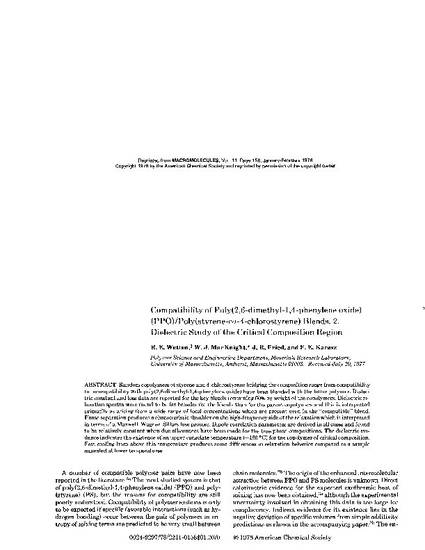
Article
Compatibility of Poly(2, 6-dimethyl-1,4-phenylene oxide) (PPO)/Poly(styrene-co-4-chlorostyrene) Blends. II. Dielectric Study of the Critical Composition Region
Macromolecules
(1978)
Abstract
Random copolymers of styrene and 4-chlorostyrene bridging the composition range from compatibility to incompatibility with poly(2,6-dimethyl-1,4-phenylene oxide) have been blended with the latter polymer. Dielectric constant and loss data are reported for the key blends containing 60% by weight of the copolymers. Dielectric relaxation spectra were found to be far broader for the blends than for the parent copolymers and this is interpreted primarily as arising from a wide range of local concentrations which are present even in the "compatible" blend. Phase separation produces a characteristic shoulder on the high-frequency side of the relaxation which is interpreted in terms of a Maxwell-Wagner-Sillars loss process. Dipole correlation parameters are derived in all cases and found to be relatively constant when due allowances have been made for the true phase compositions. The dielectric evidence indicates the existence of an upper consolate temperature (-180 °C) for the copolymer of critical composition. Fast cooling from above this temperature produces some differences in relaxation behavior compared to a sample annealed at lower temperatures.
Keywords
- Compatibility,
- Poly(2 6-dimethyl-1 4-phenylene oxide),
- (PPO)/Poly(styrene-co-4-chlorostyrene),
- Dielectric,
- Critical Composition Region
Disciplines
Publication Date
1978
Citation Information
William MacKnight, R. E. Wetton, J. R. Fried and F. E. Karasz. "Compatibility of Poly(2, 6-dimethyl-1,4-phenylene oxide) (PPO)/Poly(styrene-co-4-chlorostyrene) Blends. II. Dielectric Study of the Critical Composition Region" Macromolecules Vol. 11 (1978) p. 158 - 165 Available at: http://works.bepress.com/william_macknight/60/
